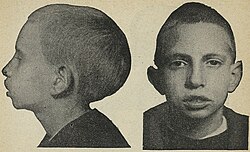Dolichocephaly

Editor-In-Chief: Prab R Tumpati, MD
Obesity, Sleep & Internal medicine
Founder, WikiMD Wellnesspedia &
W8MD medical weight loss NYC and sleep center NYC
| Dolichocephaly | |
|---|---|

| |
| Synonyms | Scaphocephaly |
| Pronounce | N/A |
| Specialty | N/A |
| Symptoms | Elongated head shape |
| Complications | Developmental delay, cranial asymmetry |
| Onset | Congenital |
| Duration | Lifelong |
| Types | N/A |
| Causes | Genetic factors, premature birth |
| Risks | Premature birth, multiple births |
| Diagnosis | Physical examination, imaging studies |
| Differential diagnosis | Brachycephaly, plagiocephaly |
| Prevention | None |
| Treatment | Helmet therapy, surgery |
| Medication | N/A |
| Prognosis | Generally good with treatment |
| Frequency | Common in premature infants |
| Deaths | N/A |

Dolichocephaly is a condition where the head is longer than would be expected, relative to its width. In humans, this cranial shape is seen in individuals with certain genetic disorders, such as Sotos syndrome and Marfan syndrome, or as a result of premature fusion of the skull bones.
Causes[edit]
Dolichocephaly can be caused by a variety of factors, including genetic disorders and environmental influences. Some of the most common causes include:
- Sotos syndrome: This is a genetic disorder characterized by excessive physical growth during the first few years of life. Dolichocephaly is one of the common physical characteristics of this syndrome.
- Marfan syndrome: This is a genetic disorder that affects the body's connective tissue. People with Marfan syndrome often have a long, narrow face and skull, which can result in dolichocephaly.
- Premature fusion of the skull bones: The skull is made up of several bones that are separated by sutures. If these sutures close too early, it can result in a long, narrow head shape.
Symptoms[edit]
The primary symptom of dolichocephaly is a head that is longer than it is wide. Other symptoms can vary depending on the underlying cause of the condition. For example, individuals with Sotos syndrome may also have overgrowth in childhood, learning disabilities, and distinctive facial features. Those with Marfan syndrome may also have features such as a tall and slender build, heart defects, and eye problems.
Diagnosis[edit]
Diagnosis of dolichocephaly typically involves a physical examination and medical history. Imaging tests, such as X-rays or CT scans, may be used to confirm the diagnosis and assess the severity of the condition. Genetic testing may also be performed if a genetic disorder is suspected.
Treatment[edit]
Treatment for dolichocephaly depends on the underlying cause of the condition. In some cases, no treatment may be necessary. If the condition is caused by premature fusion of the skull bones, surgery may be required to correct the shape of the head. For individuals with genetic disorders, treatment may also involve managing other symptoms of the disorder.
See also[edit]
Ad. Transform your life with W8MD's Budget GLP-1 injections from $75


W8MD offers a medical weight loss program to lose weight in Philadelphia. Our physician-supervised medical weight loss provides:
- Weight loss injections in NYC (generic and brand names):
- Zepbound / Mounjaro, Wegovy / Ozempic, Saxenda
- Most insurances accepted or discounted self-pay rates. We will obtain insurance prior authorizations if needed.
- Generic GLP1 weight loss injections from $75 for the starting dose.
- Also offer prescription weight loss medications including Phentermine, Qsymia, Diethylpropion, Contrave etc.
NYC weight loss doctor appointmentsNYC weight loss doctor appointments
Start your NYC weight loss journey today at our NYC medical weight loss and Philadelphia medical weight loss clinics.
- Call 718-946-5500 to lose weight in NYC or for medical weight loss in Philadelphia 215-676-2334.
- Tags:NYC medical weight loss, Philadelphia lose weight Zepbound NYC, Budget GLP1 weight loss injections, Wegovy Philadelphia, Wegovy NYC, Philadelphia medical weight loss, Brookly weight loss and Wegovy NYC
|
WikiMD's Wellness Encyclopedia |
| Let Food Be Thy Medicine Medicine Thy Food - Hippocrates |
Medical Disclaimer: WikiMD is not a substitute for professional medical advice. The information on WikiMD is provided as an information resource only, may be incorrect, outdated or misleading, and is not to be used or relied on for any diagnostic or treatment purposes. Please consult your health care provider before making any healthcare decisions or for guidance about a specific medical condition. WikiMD expressly disclaims responsibility, and shall have no liability, for any damages, loss, injury, or liability whatsoever suffered as a result of your reliance on the information contained in this site. By visiting this site you agree to the foregoing terms and conditions, which may from time to time be changed or supplemented by WikiMD. If you do not agree to the foregoing terms and conditions, you should not enter or use this site. See full disclaimer.
Credits:Most images are courtesy of Wikimedia commons, and templates, categories Wikipedia, licensed under CC BY SA or similar.
Translate this page: - East Asian
中文,
日本,
한국어,
South Asian
हिन्दी,
தமிழ்,
తెలుగు,
Urdu,
ಕನ್ನಡ,
Southeast Asian
Indonesian,
Vietnamese,
Thai,
မြန်မာဘာသာ,
বাংলা
European
español,
Deutsch,
français,
Greek,
português do Brasil,
polski,
română,
русский,
Nederlands,
norsk,
svenska,
suomi,
Italian
Middle Eastern & African
عربى,
Turkish,
Persian,
Hebrew,
Afrikaans,
isiZulu,
Kiswahili,
Other
Bulgarian,
Hungarian,
Czech,
Swedish,
മലയാളം,
मराठी,
ਪੰਜਾਬੀ,
ગુજરાતી,
Portuguese,
Ukrainian


